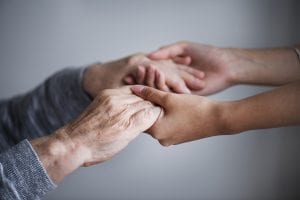By Trena Winans, Education & Outreach Director
Every once in a while, there is a lot of press about suicide following the deaths of celebrities or very young people. Most of the time when suicide is discussed, it is in reference to teens, but you may be surprised to learn how often highly accomplished people above the age of 50 are the victims.
As it turns out, suicide rates amongst aging adults are disturbingly high. Depression has no age limit. According to Dr. Jo Anne Sirey of the Suicide Prevention Resource Center, people over 65 years of age have a high rate of suicide and those over 85 having the highest suicide rate of all adults.
 That being so, why is this population so often left out of the conversation about suicide? One likely reason is that depression is frequently not recognized by professionals or older adults themselves. Too often, people assume that feeling down or sad is a normal part of aging when, in fact, older adults are typically happier than the rest of the adult population. Another likely cause is that the stigma around mental health is greater among older people than it is in the youth population. As a result, older adults are less likely to seek help in the first place and less prone to follow through on prescribed treatment recommendations for medication and counseling when they do speak with their physician.
That being so, why is this population so often left out of the conversation about suicide? One likely reason is that depression is frequently not recognized by professionals or older adults themselves. Too often, people assume that feeling down or sad is a normal part of aging when, in fact, older adults are typically happier than the rest of the adult population. Another likely cause is that the stigma around mental health is greater among older people than it is in the youth population. As a result, older adults are less likely to seek help in the first place and less prone to follow through on prescribed treatment recommendations for medication and counseling when they do speak with their physician.
One factor that contributes to the high rate of suicide among elders is loneliness as their spouse, friends, and other social networks die or move away. When people retire and are no longer close to colleagues, they lose opportunities to be social and are less likely to create new social networks. Isolation and lack of connectedness can be a significant contributor to depression. People are social beings who need human connections to thrive.
Another key factor is when a person experiences a change of health. A new diagnosis can increase fear of becoming a ‘burden’ to loved ones. For some, embarrassment about their health condition is a factor. I vividly remember hearing of the suicide of an older gentleman who simply could not stand the thought of living his life with a colostomy bag.
For yet others, they have suffered depression their entire life. Their sense of despair may have intensified with age as losses accrue and they may not know where to turn for help. It is also important to recognize that depression doesn’t necessarily show up as sadness in older adults, but as irritability or physical complaints with no apparent cause. The cry for help by an elder may look markedly different than the signs coming from a teenager.
So what can we do to assist others or ourselves in recognizing when and how to get help? First, know that depression is not a normal part of aging. Withdrawing from life, thoughts or words about wishing they were dead, feeling there is no place for them, or deep fears of becoming a burden are signals that need to be taken seriously. Speak with the person, or if you are having those thoughts, speak with a doctor or trusted friend or family member about these feelings. It is not only ok to seek help, it is critical. Medication and counseling can make a huge difference.

Closeup of a support hands
While we are unable to handle crisis situations, here at Senior Services we have integrated counseling into our services. Joining in activities in places where older adults gain new friendships through gentle exercise classes, support groups, and more is harder than it used to be due to COVID restrictions, but there are still ways to connect. Senior Services, the Community Center, and others are working hard to give you safe opportunities to build or maintain connections that foster a sense of purpose.
There is, of course, a National Suicide Prevention Hotline that is an excellent resource at 1-800-273-8255, but there is also a hotline created just for older adults called The Friendship Line. The Friendship Line is available 24 hours a day, 365 days a year at 1-800-971-0016.
I hope we can all find ways to look out for our aging neighbors, friends, and colleagues and try to connect them to help when needed. And to those who are struggling with depression themselves, please reach out. Help and hope are available.
Resources:
How Do We Stop The Elderly Suicide Epidemic? By Roseann Bennett, Executive Director of Center for Assessment and Treatment, Published by The Huffington Post on 09/06/2017
The Suicide Prevention Resource Center at www.sprc.org
The Institute on Aging friendship Line at https://www.ioaging.org/services/all-inclusive-health-care/friendship-line

